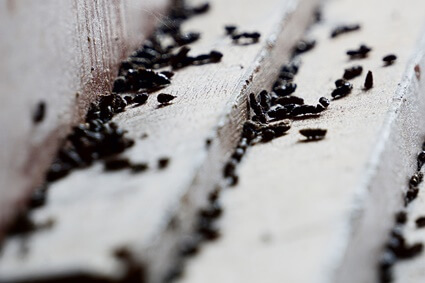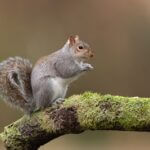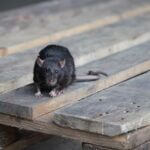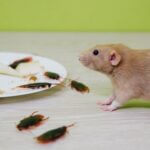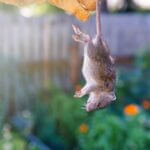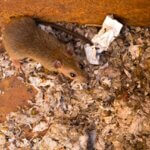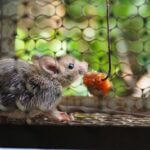When determining the type of a rodent infestation, you need to find evidence. Identifying whether droppings belong to rats or mice can be challenging since mice produce similar-looking waste.
Mouse droppings are brown, spindle-shaped pellets that measure about ¼ of an inch long. Rat droppings are sausage-shaped, shiny black or dark grey in color, and measure ½ to ¾ of an inch in length.
Mice produce 70-150 pellets a day, while rats produce 40-50 pellets a day.
Examining rodent feces enables you to determine the scale of an infestation. That way, it’s easier to devise control measures. Pests, like cockroaches and bats, also leave behind droppings similar to mice.
Rat Poop Compared To Mouse Poop
Of course, rats and mice have similar-looking poop. However, you can look for differences to determine which rodents you have in your home.
Characteristics of mouse and rat poop include:
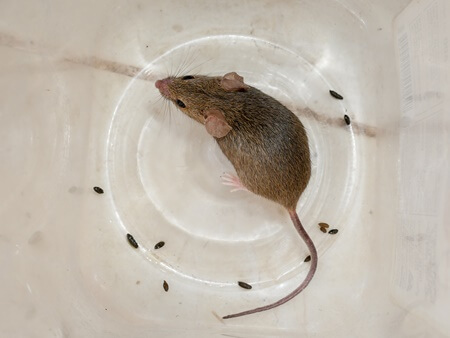
Mouse Poop
Mouse droppings are small, measuring only about a quarter of an inch.
While cylindrical, they tend to be fatter in the middle and more pointed toward the ends. In terms of color, mouse droppings are dark brown when fresh and moldy grey when old.
A defining characteristic of mouse poop is the number of droppings.
Mice leave behind a large number of droppings compared to rats. A mouse can excrete between 70 and 150 droppings in a single day.
According to Nutrition and Metabolism, mice engage in coprophagia (consumption of feces). So, you may find lower quantities of droppings if the mice in your home are starved.
There are certain locations where you’re likely to find mouse droppings, including:
- Behind food boxes
- At the back of silverware drawers
- Under kitchen sinks
These locations are common nesting grounds for cockroaches, which also leave behind droppings. So, it’s possible to mistake cockroach feces for mouse droppings.
If you’re unsure which is which, you can tell by checking for poop smears on the walls. This is a sign of cockroaches rather than mice.
Rat Poop
Rat droppings are larger than mice droppings, measuring about a half to three-quarters of an inch.
They’re pellet-shaped in appearance and black or dark grey. In addition, rat poop is soft to the touch when fresh and has a crumbly texture when old.
Rats leave behind fewer droppings than mice. The average rat will excrete about 40 to 50 pellets in a single day, which you may find in small or large groups.
Norway rats (brown rats) love nesting in underground locations such as floorboards and basements. You’re likely to find their droppings in these areas.
Roof rats (brown rats) prefer living on raised surfaces like treetops, roof heaves, and attics. If you find pellet-shaped droppings in these locations, you’re dealing with a roof rat.
How to Identify Rat vs. Mouse Poop
If you’ve seen poop before or have two droppings side-by-side, check for these differences:
Size
Mouse droppings are smaller than rat droppings. So, you can tell whether rats or mice left the droppings by looking at the size.
A single pellet of mouse poop measures about a quarter of an inch. By contrast, rats’ droppings measure between one-half to three-quarters of an inch.
Shape
Mice and rat droppings can be differentiated by their unique shapes.
While a mouse’s droppings are straight and fat in the middle with thin and pointed tips, a rat’s droppings tend to be sausage-shaped and curved.
Quantity
Mice leave many droppings, usually 70 to 150 pellets per day, while rats leave 40 to 50 pellets a day.
Color
Rats’ droppings may range in color from shiny black to dark brown when fresh and grey when old. Mouse droppings are brown when fresh and moldy-grey when old.
Location
Mice are less cautious than rats and will come out in the open more often when foraging for food, water, and shelter. You’re likely to find their poop behind kitchen appliances and under the sink.
Rats prefer to spend most of their time in hidden locations. Consequently, you’re likely to find their droppings in isolated areas.
Roof rats like to nest in attics, treetops, and inside roofs. Norway rats like to nest and forage in subterranean spaces such as floorboards, sewers, and basements.
According to Neglected Tropical Disease, the poop of rats and mice contain pathogens that can be transmitted to humans. So, you should refrain from touching rodent droppings with your bare hands.
What Does Rat Poop Look Like?
Rat poop has physical characteristics that set it apart from the droppings of other pests, such as mice and cockroaches. Here are some of the main features:
- Large pellets measuring between ½ to ¾ inch
- Shiny black or grey in color
- Curved and sausage-shaped
- Soft and glistening when fresh
- Crumbly texture when dry
- 40 to 50 pellets per day
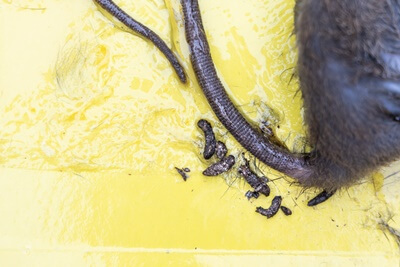
What Does Mouse Poop Look Like?
Mouse poop is often mistaken for cockroach feces.
That’s not just because it’s similar in appearance but because it’s commonly found in places where cockroaches congregate.
However, certain characteristics allow you to tell whether you’ve found mouse poop, including:
- Small pellets measuring about ¼ inch
- Spindle-shaped pellets with pointed tips
- Dark brown and soft to the touch when fresh
- Moldy grey in color and dusty in texture when old
- Large amount of pellets, about 70 to 150
Are Rats Droppings Bigger than Mouse Droppings?
Rats’ droppings are substantially larger than mouse droppings.
A pellet of a rat’s poop measures between ½ to ¾ of an inch, whereas a pellet of mouse poop measures only about ¼ inch in length.
Below is a table highlighting the size difference and physical characteristics of rat and mouse droppings:
| Identifiers | Rat Droppings | Mouse Droppings |
| Size | ½ to ¾ inches | ¼ inches |
| Shape | Spindle-shaped, fat in the middle and pointed ends | Sausage-shaped and curved |
| Color | Black when fresh, grey when old | Dark brown when fresh, moldy grey when old |
| Quantity | 40 to 50 pellets per day | 70 to 150 pellets per day |
What Can Be Mistaken For Mouse Poop?
There are other creatures whose droppings can be mistaken for mouse poop, including:
Cockroaches
Cockroach poop usually looks like coarse ground paper. So, it’s easy to mistake it for old mouse pellets that have dried up and crumbled.
However, one way to tell them apart is to look for any signs of poop smears on walls and other surfaces.
Bats
Bats’ droppings look similar to mouse droppings in terms of size. However, they have a rougher appearance than mouse poop and are much softer.
A bat’s droppings will crumble at the lightest touch, unlike mouse droppings which are firmer.
What Does Rat Poop Smell Like?
Rat poop has a strong musky odor, which is one of the first signs of infestation.
Fresh rat droppings tend to produce a stronger odor than old droppings that have started to dry up. That’s because they’re often mixed with urine, which has an offensive smell.
What Does Mouse Poop Smell Like?
Mouse poop has a pungent ammonia smell, which is hard to ignore. This strong odor usually comes from the urine that’s mixed with poop when they excrete.

